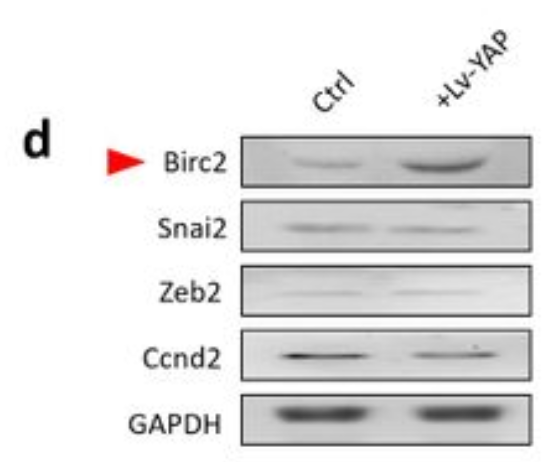产品描述
*The optimal dilutions should be determined by the end user.
*Tips:
WB: 适用于变性蛋白样本的免疫印迹检测. IHC: 适用于组织样本的石蜡(IHC-p)或冰冻(IHC-f)切片样本的免疫组化/荧光检测. IF/ICC: 适用于细胞样本的荧光检测. ELISA(peptide): 适用于抗原肽的ELISA检测.
引用格式: Affinity Biosciences Cat# DF6167, RRID:AB_2838134.
展开/折叠
API 1; API1; Apoptosis inhibitor 1; Baculoviral IAP repeat containing 2; Baculoviral IAP repeat containing protein 2; Baculoviral IAP repeat-containing protein 2; BIRC 2; BIRC2; BIRC2_HUMAN; C IAP1; C-IAP1; cIAP 1; cIAP1; HIAP 2; HIAP-2; HIAP2; IAP 2; IAP homolog B; IAP-2; IAP2; Inhibitor of apoptosis protein 2; MIHB; NFR2 TRAF signalling complex protein; RING finger protein 48; RNF 48; RNF48; TNFR2 TRAF signaling complex protein 2; TNFR2-TRAF-signaling complex protein 2;
抗原和靶标
Present in many fetal and adult tissues. Mainly expressed in adult skeletal muscle, thymus, testis, ovary, and pancreas, low or absent in brain and peripheral blood leukocytes.
- Q13490 BIRC2_HUMAN:
- Protein BLAST With
- NCBI/
- ExPASy/
- Uniprot
MHKTASQRLFPGPSYQNIKSIMEDSTILSDWTNSNKQKMKYDFSCELYRMSTYSTFPAGVPVSERSLARAGFYYTGVNDKVKCFCCGLMLDNWKLGDSPIQKHKQLYPSCSFIQNLVSASLGSTSKNTSPMRNSFAHSLSPTLEHSSLFSGSYSSLSPNPLNSRAVEDISSSRTNPYSYAMSTEEARFLTYHMWPLTFLSPSELARAGFYYIGPGDRVACFACGGKLSNWEPKDDAMSEHRRHFPNCPFLENSLETLRFSISNLSMQTHAARMRTFMYWPSSVPVQPEQLASAGFYYVGRNDDVKCFCCDGGLRCWESGDDPWVEHAKWFPRCEFLIRMKGQEFVDEIQGRYPHLLEQLLSTSDTTGEENADPPIIHFGPGESSSEDAVMMNTPVVKSALEMGFNRDLVKQTVQSKILTTGENYKTVNDIVSALLNAEDEKREEEKEKQAEEMASDDLSLIRKNRMALFQQLTCVLPILDNLLKANVINKQEHDIIKQKTQIPLQARELIDTILVKGNAAANIFKNCLKEIDSTLYKNLFVDKNMKYIPTEDVSGLSLEEQLRRLQEERTCKVCMDKEVSVVFIPCGHLVVCQECAPSLRKCPICRGIIKGTVRTFLS
种属预测
score>80的预测可信度较高,可尝试用于WB检测。*预测模型主要基于免疫原序列比对,结果仅作参考,不作为质保凭据。
High(score>80) Medium(80>score>50) Low(score<50) No confidence
研究背景
Multi-functional protein which regulates not only caspases and apoptosis, but also modulates inflammatory signaling and immunity, mitogenic kinase signaling, and cell proliferation, as well as cell invasion and metastasis. Acts as an E3 ubiquitin-protein ligase regulating NF-kappa-B signaling and regulates both canonical and non-canonical NF-kappa-B signaling by acting in opposite directions: acts as a positive regulator of the canonical pathway and suppresses constitutive activation of non-canonical NF-kappa-B signaling. The target proteins for its E3 ubiquitin-protein ligase activity include: RIPK1, RIPK2, RIPK3, RIPK4, CASP3, CASP7, CASP8, TRAF2, DIABLO/SMAC, MAP3K14/NIK, MAP3K5/ASK1, IKBKG/NEMO, IKBKE and MXD1/MAD1. Can also function as an E3 ubiquitin-protein ligase of the NEDD8 conjugation pathway, targeting effector caspases for neddylation and inactivation. Acts as an important regulator of innate immune signaling via regulation of Toll-like receptors (TLRs), Nodlike receptors (NLRs) and RIG-I like receptors (RLRs), collectively referred to as pattern recognition receptors (PRRs). Protects cells from spontaneous formation of the ripoptosome, a large multi-protein complex that has the capability to kill cancer cells in a caspase-dependent and caspase-independent manner. Suppresses ripoptosome formation by ubiquitinating RIPK1 and CASP8. Can stimulate the transcriptional activity of E2F1. Plays a role in the modulation of the cell cycle.
Auto-ubiquitinated and degraded by the proteasome in apoptotic cells.
Upon stimulation of death receptors, including TNFRSF10B, recruited to receptors and cleaved by caspases. Proteolytic fragments remain associated with the receptors. This cleavage presumably inactivates the protein.
Cytoplasm. Nucleus.
Note: Agents that induce either the extrinsic or intrinsic apoptotic pathways promote its redistribution from the nuclear compartment to the cytoplasmic compartment. Associated with the midbody in telophase cells, and found diffusely in the nucleus of interphase cells.
Present in many fetal and adult tissues. Mainly expressed in adult skeletal muscle, thymus, testis, ovary, and pancreas, low or absent in brain and peripheral blood leukocytes.
Interacts with DIABLO/SMAC and with PRSS25; these interactions inhibit apoptotic suppressor activity. Interacts with CASP9. Interacts (via BIR domains) with TRAF2; the interaction is required for IKBKE ubiquitination. Interacts with E2F1, RIPK1, RIPK2, RIPK3, RIPK4, BIRC5/survivin and USP19. HSP90AB1. Interacts with UBXN1. Interacts with GSK3B. Interacts with several death receptors, inclusing FAS, TNFRSF10A and TNFRSF10B. Recruited to TNFRSF10B in the absence of receptor stimulation. When TNFRSF10B is stimulated, further recruited to the receptor and cleaved by caspases. Proteolytic fragments remain associated with TNFRSF10B.
The BIR domains mediate nuclear localization.
The CARD domain is necessary to stabilize the protein and inhibit the activation of E3 ubiquitin-protein ligase activity of BIRC2/c-IAP1 by preventing RING domain dimerization and E2 ubiquitin donor binding and activation.
Belongs to the IAP family.
研究领域
· Cellular Processes > Cell growth and death > Apoptosis. (View pathway)
· Cellular Processes > Cell growth and death > Apoptosis - multiple species. (View pathway)
· Cellular Processes > Cell growth and death > Necroptosis. (View pathway)
· Cellular Processes > Cellular community - eukaryotes > Focal adhesion. (View pathway)
· Environmental Information Processing > Signal transduction > NF-kappa B signaling pathway. (View pathway)
· Environmental Information Processing > Signal transduction > Hippo signaling pathway. (View pathway)
· Environmental Information Processing > Signal transduction > TNF signaling pathway. (View pathway)
· Genetic Information Processing > Folding, sorting and degradation > Ubiquitin mediated proteolysis. (View pathway)
· Human Diseases > Drug resistance: Antineoplastic > Platinum drug resistance.
· Human Diseases > Infectious diseases: Parasitic > Toxoplasmosis.
· Human Diseases > Cancers: Overview > Pathways in cancer. (View pathway)
· Human Diseases > Cancers: Specific types > Small cell lung cancer. (View pathway)
· Organismal Systems > Immune system > NOD-like receptor signaling pathway. (View pathway)
文献引用
Application: IHC Species: Human Sample: Ameloblastoma
Application: WB Species: Human Sample: CSPCs
限制条款
产品的规格、报价、验证数据请以官网为准,官网链接:www.affbiotech.com | www.affbiotech.cn(简体中文)| www.affbiotech.jp(日本語)产品的数据信息为Affinity所有,未经授权不得收集Affinity官网数据或资料用于商业用途,对抄袭产品数据的行为我们将保留诉诸法律的权利。
产品相关数据会因产品批次、产品检测情况随时调整,如您已订购该产品,请以订购时随货说明书为准,否则请以官网内容为准,官网内容有改动时恕不另行通知。
Affinity保证所销售产品均经过严格质量检测。如您购买的商品在规定时间内出现问题需要售后时,请您在Affinity官方渠道提交售后申请。产品仅供科学研究使用。不用于诊断和治疗。
产品未经授权不得转售。
Affinity Biosciences将不会对在使用我们的产品时可能发生的专利侵权或其他侵权行为负责。Affinity Biosciences, Affinity Biosciences标志和所有其他商标所有权归Affinity Biosciences LTD.





